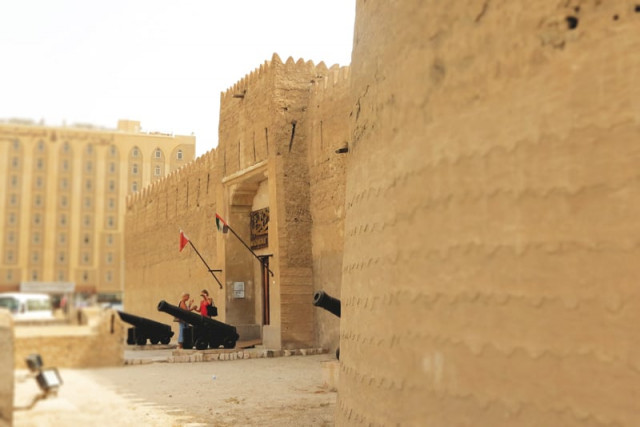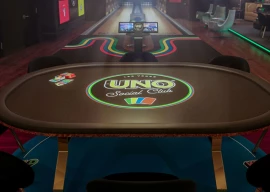

A traditional khanjar (carved dagger) displayed in the weaponry exhibit. PHOTO: UROOJ QURESHI
Constructed from sea rocks and gypsum, the Al-Fahidi Fort reminds visitors of the more humble past and the traditional lifestyle of the Emirati people. Measuring 41m long by 33m wide and consisting of three towers which are roughly 13m high, the Al-Fahidi is a far cry from the mega structures that dominate Dubai’s skyline. For this building though, size does not matter. Up until 1971, the fort served as the residence to Dubai’s rulers as well as the seat of government. Today it is home to the Dubai Museum, which attracts thousands of visitors annually with its majestic charm and entertaining exhibits.

Tabura (harp), a musical instrument, made from wood and deerskin, displayed inside the fort. PHOTO: UROOJ QURESHI
Take a step inside the fort and it feels like you have entered an oasis in a vast desert. The main gate, made of solid teak, studded with large iron nails, and decorated with brass plates, leads to the main corridor and ticket booth. In the past, such corridors were designed to act as a part of the fort’s defense systems — if the outer wall was breached, the enemy faced the armed guards and an impenetrable second wall. Today these corridors have been transformed into narrow exhibit halls. One such hall houses a fascinating display of traditional weapons including beautiful old silver khanjars (curved daggers) decorated with camel bone and swords inscribed with calligraphy. Another such hall is dedicated to Emirati music and dances featuring garments and instruments used for performances.

Courtyard of Al-Fahidi Fort, the main defence to the fishing village that was Dubai. PHOTO: UROOJ QURESHI
Guarded by towering walls, the fort’s courtyard was once the centre of all important activities in Dubai. The enclosure can be accessed by traditional barasti (palm-leaf) houses. Two types of barasti can be found attached to the courtyard. The first, called al-kaimah is a primitive one-room house that was a common abode for residents of the Gulf coast before modern mansions replaced them. The second type of structure is called al-arish. It served as summer house with a barajeel (wind tower) designed to funnel wind blowing from any direction to naturally air condition the house. The innovative concept of barajeel is also a testament to the ingenuity of the people in this region. Step inside the al-arish and test it out — you won’t believe it’s over 40 degrees celsius outside!

A traditional dhow, a vessel used for sailing and transporting merchandise, displayed outside Dubai Museum. PHOTO: UROOJ QURESHI
In the fort’s courtyard are several small wooden boats. Similar ones can still be found in operation on the Gulf coast but for the most part they have been replaced by luxury yachts and large container ships. I was particularly impressed by al-hourey, a small boat carved from a single tree trunk. However, it was boats like al-baggarah and al-sambuk that were used for pearling and fishing, respectively, which were Dubai’s pride before the discovery of petroleum.

Al-sambuk, a traditional wooden, fishing vessel displayed inside the fort. PHOTO: UROOJ QURESHI
The Al-Fahidi Fort offers as much below the surface as it does above. An entrance under one of the fortresses fairytale-like towers leads to a spiral staircase which descends to the exhibit area of Dubai Museum. The museum’s collection vividly charts Dubai’s rapid growth from a village and one of the world’s first free-trade ports to the Arabian mega city it has become now. All first-time visitors should consider making the museum their first stop in Dubai. An hour or two meandering through interactive presentations gives you a quick and comprehensive introduction to the city’s history, culture and traditions. Just in case you were not convinced, a multimedia presentation and a series of dioramas brought to life by hologram-like projections will leave you with a greater appreciation for what a nomadic desert community has accomplished.

A traditional kitchen attached to the al-kaimah, a primitive house that was a common abode for Emirati’s. PHOTO: UROOJ QURESHI
Visitors get a complete sensory experience by walking through life-size scenes representing life in the souqs, madrassahs, social life, education, architecture, the desert and oasis, star gazing and my favourite, the underwater sea exhibition.

A typical Emirati shop from a pre-modernisation era. PHOTO: UROOJ QURESHI
One exhibit which truly enlightened me was from the Al-Qusais archeological site dating back to 2,500BC and 5,000BC. It turns out there’s far more to this fascinating city than what we know. Whenever I thought of Dubai, I imagined luxury cars, tall buildings, yachts, and everything that is material — covered in gold. I suppose like many I have been judging a book only by its cover.

Children being taught at a madrassah. PHOTO: UROOJ QURESHI

The south-western tower of the fort seen from inside the fort. PHOTO: UROOJ QURESHI

Bronze arrowheads from the graves of Al-Qusais dating back to second millenium BC. PHOTO: UROOJ QURESHI

The north-western tower of the Al-Fahidi Fort. PHOTO: UROOJ QURESHI

Al-arish, an Arab summer house, which has a wind tower designed to naturally air condition the house. PHOTO: UROOJ QURESHI
Urooj Qureshi is a traveller who loves to tell stories. He tweets @uroojqureshi
Published in The Express Tribune, Sunday Magazine, September 21st, 2014.


















COMMENTS
Comments are moderated and generally will be posted if they are on-topic and not abusive.
For more information, please see our Comments FAQ